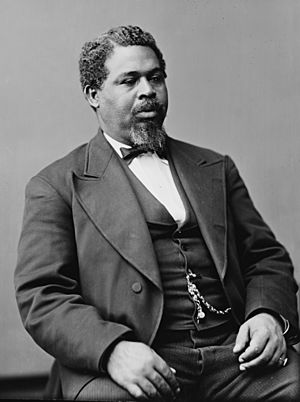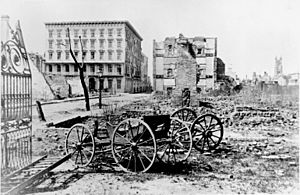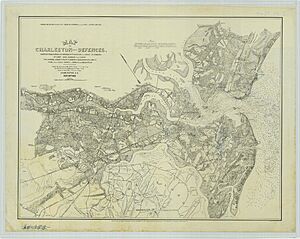South Carolina in the American Civil War facts for kids
Quick facts for kids South Carolina |
|||||
|---|---|---|---|---|---|
| Nickname(s): "Palmetto Republic" | |||||
|
|||||
| Capital | Columbia | ||||
| Largest City | Charleston | ||||
| Admission to confederacy | April 3, 1861 (6th) | ||||
| Population |
|
||||
| Forces supplied |
|
||||
| Major garrisons/armories | Fort Sumter, Charleston Harbor | ||||
| Governor | 1860–1862 Francis Pickens 1862–1864 Milledge Bonham 1864–1865 Andrew Magrath |
||||
| Senators | Robert Woodward Barnwell James Lawrence Orr |
||||
| Representatives | List | ||||
| Restored to the Union | July 9, 1868 | ||||
South Carolina played a very important role in the American Civil War. It was the first state to leave the United States in December 1860. In February 1861, it became one of the first states to form the Confederacy.
The war officially began when Confederate forces attacked the U.S. Army at Fort Sumter in Charleston Harbor on April 12, 1861. This event is seen as the first military action of the war. When the Union Army took Charleston back in February 1865, and raised the U.S. flag again at Fort Sumter, it was a big symbol of victory for the Union.
South Carolina sent about 60,000 soldiers to the Confederate Army. As the war went on, many formerly enslaved people and free Black people from South Carolina joined U.S. Colored Troops regiments to fight for the Union Army. Most Black people in South Carolina were enslaved when the war started. The state also provided uniforms, food, and war supplies. Trained soldiers and leaders came from military schools like The Citadel. Unlike most other Confederate states, South Carolina had a good railroad system connecting its main cities.
South Carolina was mostly free from Union occupation until the very end of the war. It had several prisoner of war camps. It was also the only Confederate state that didn't have many white people who supported the Union. However, the Upstate region of the state became a hiding place for Confederate soldiers who deserted or resisted joining the army. They used the mountains and local community ties to avoid fighting.
Some important Confederate generals from South Carolina included Wade Hampton III, a famous cavalry leader, and Maxcy Gregg, who died in battle. Joseph B. Kershaw's infantry brigade fought in some of the toughest battles. James Longstreet was a senior general, and Stephen D. Lee was the youngest general.
Contents
Why South Carolina Left the Union
For many years, white people in South Carolina strongly supported slavery. Political leaders like John Calhoun and Preston Brooks often spoke about protecting slavery. They even threatened to leave the United States if slavery was challenged.
These leaders argued for "states' rights" but mainly used this idea to protect slavery. They believed that each state should control its own laws, especially regarding slavery.
One politician, Alfred P. Aldrich, said that if a Republican won the 1860 U.S. presidential election, South Carolina would have to secede. He believed this was the only way to keep slavery and stop the anti-slavery Republican Party. He felt that if slavery was abolished, it would "destroy the South."
Another South Carolina congressman, Laurence M. Keitt, said in 1860 that the anti-slavery party believed slavery was wrong. But he argued that people in the South believed slavery was right. Later that year, he clearly stated that South Carolina's decision to secede was directly because of slavery.
South Carolina Declares Independence
On November 9, 1860, South Carolina's government declared that Abraham Lincoln's election as U.S. President was a "Hostile Act." They announced their plan to leave the United States.
In December 1860, a former congressman, John McQueen, wrote a letter explaining why South Carolina wanted to secede. He said that President-elect Lincoln supported equal rights for African Americans and wanted to end slavery. Because South Carolina was against these ideas, it felt forced to leave the Union. McQueen wrote that South Carolina hoped to join other Southern states to form a "Southern Confederacy, where white men shall rule our destinies."
A minister named James Henley Thornwell also said that slavery was supported by the Christian religion. He believed that those who thought slavery was wrong were against Christianity. A South Carolina newspaper, the Southern Presbyterian, even said that being anti-slavery was "essentially infidel."
On December 10, 1860, South Carolina decided to hold a special meeting to discuss secession. On December 17, this meeting took place in Columbia. All 169 delegates voted to declare secession from the United States. They then moved to Charleston to write an official document.
On December 20, 1860, South Carolina officially adopted its secession document. This made it the first slave state in the South to declare it had left the United States. The U.S. President, James Buchanan, said this was illegal but did not stop it.
The state also wrote a Declaration of the Immediate Causes Which Induce and Justify the Secession of South Carolina. This document, adopted on December 24, explained why South Carolina was leaving. It mainly said that the "increasing hostility" of non-slaveholding states towards slavery was the reason.
The declaration also complained that free states refused to enforce the Fugitive Slave Acts. These laws required runaway enslaved people to be returned to their owners. South Carolina argued that the U.S. Constitution protected the right to own enslaved people. It claimed that because the Northern states ignored these rules, South Carolina was no longer bound to stay in the Union.
Another big concern was Lincoln's election. They believed he wanted to see slavery "in the course of ultimate extinction," meaning he wanted it to eventually end.
Historian Harry V. Jaffa pointed out that South Carolina's declaration was different from the original United States Declaration of Independence. South Carolina's version left out phrases like "all men are created equal" and "endowed by their Creator with certain unalienable Rights." Jaffa said this was because South Carolinians, with their pro-slavery views, did not believe in these ideas for everyone.
On December 25, 1860, South Carolina sent an "Address to the Slaveholding States." It asked other states to join them in forming a "Confederacy of Slaveholding States." They praised their system where "labor and capital are identified in interest," meaning enslaved labor was key to their economy.
Sociologist James W. Loewen explained that South Carolina was upset that Northern states like New York no longer allowed slave owners to bring their enslaved people with them when traveling. They also disliked that New England states allowed Black men to vote and tolerated groups that wanted to end slavery.
After seceding, South Carolina adopted the palmetto flag as its symbol. This flag is still used today. South Carolina was often called the "Palmetto Republic."
On February 4, 1861, delegates from South Carolina and five other states met in Montgomery, Alabama. They created a new government and constitution similar to the United States'. On February 8, 1861, South Carolina officially joined the Confederacy. A South Carolina newspaper editor wrote that "The South is now in the formation of a Slave Republic."
Religious leaders in South Carolina also supported secession. They claimed it was in line with their religious beliefs. One leader, John T. Wightman, said, "The triumphs of Christianity rest this very hour upon slavery; and slavery depends on the triumphs of the South... This war is the servant of slavery."
American Civil War in South Carolina
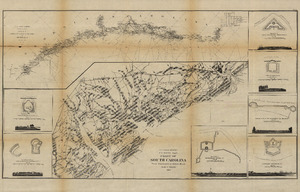
Fort Sumter: Where the War Began
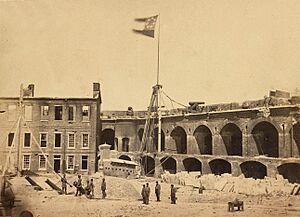
Six days after South Carolina seceded, on December 26, 1860, Major Robert Anderson moved his U.S. troops to Fort Sumter. This fort was on an island in Charleston Harbor. South Carolina militia quickly took over the abandoned forts on the mainland and aimed their cannons at Fort Sumter. Taking Fort Sumter was important for the Confederates because it controlled the harbor. If U.S. forces stayed there, South Carolina's claim of independence would seem weak.
On January 9, 1861, a U.S. ship called the Star of the West tried to bring supplies to the fort. Students from The Citadel, The Military College of South Carolina fired on the ship, hitting it three times. The ship had to turn back to New York.
Other Southern states soon followed South Carolina in seceding. Both the outgoing U.S. President Buchanan and President-elect Lincoln said that no state had the right to secede. Meanwhile, a Virginian speaker, Roger Atkinson Pryor, came to Charleston. He said that the only way Virginia would join the Confederacy was if South Carolina started a war with the United States. Fort Sumter was the obvious place to start.
On April 10, 1861, news spread that U.S. Navy ships were heading towards Charleston. Lincoln told South Carolina's governor that the ships were only bringing supplies, not more soldiers. The Carolinians decided they had to take the fort before the U.S. Navy arrived. About 6,000 Confederate soldiers were ready to attack the 60 men in Fort Sumter.
At 4:30 a.m. on April 12, after two days of talks, the firing began. Students from The Citadel were among those who fired the first shots. Thirty-four hours later, Major Anderson's men surrendered. They were allowed to leave the fort with their flag and drums. As they lowered the U.S. flag, they fired a 50-gun salute. During this salute, one cannon exploded, killing a young soldier. This was the only death during the bombardment and the first casualty of the war.
In December 1861, South Carolina received $100,000 from Georgia after a terrible fire in Charleston.
Robert Smalls: A Hero's Story
Robert Smalls (1839–1915) was born into slavery in Beaufort, South Carolina. On May 13, 1863, he became a hero. He took control of a Confederate transport ship, the CSS Planter, in Charleston Harbor. He sailed it past the Confederate defenses to the U.S. Navy ships blocking the harbor. He then piloted the ship to a Union-controlled area.
Smalls' brave act helped convince President Abraham Lincoln to allow African-American soldiers to join the Union Army. After the war, Smalls helped start the Republican Party in South Carolina. He was elected to the U.S. Congress five times.
Fort Wagner: A Battle for Equality
Fort Wagner was the site of two important battles. The First Battle of Fort Wagner happened on July 11, 1863. Only 12 Confederate soldiers were killed, but the Union lost 339 men.
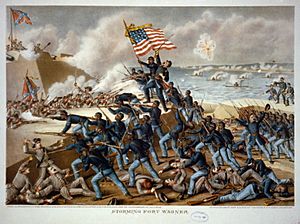
The Second Battle of Fort Wagner, a week later, is more famous. This was a Union attack on July 18, 1863, led by the 54th Massachusetts Volunteer Infantry. This was one of the first major U.S. military units made up of Black soldiers. Colonel Robert Gould Shaw led the 54th Massachusetts into the attack and was killed.
Even though the Union lost this battle, the bravery of the Black troops at Fort Wagner was widely reported. This led to more opportunities for Black soldiers in the Civil War. It also encouraged more Black men to join the Union Army, giving the Union a greater number of soldiers than the South.
After the failed attack, the Union Army surrounded the fort. They shelled it for almost 60 days. The Confederates finally left the fort on the night of September 6–7, 1863, taking their cannons and soldiers with them.
Port Royal Experiment: A New Beginning
The Port Royal Experiment was a program where formerly enslaved people worked on land left behind by plantation owners. In 1861, the Union captured the Sea Islands off the coast of South Carolina. The white residents fled, leaving behind 10,000 enslaved Black people.
Northern charity groups came to help. They set up schools and helped the formerly enslaved people become independent. This program showed what Reconstruction could have been like. The African Americans showed they could farm the land well and live without white control. They grew cotton and their own crops, fished, and hunted. By selling their extra crops, they were able to buy small pieces of land.
Charleston During the War
The city of Charleston was under siege for a long time. It became a center for "blockade running," where ships tried to sneak past Union blockades to bring supplies. On February 17, 1864, Charleston was the site of the first successful submarine attack. The Confederate submarine H.L. Hunley attacked and sank the USS Housatonic.
In 1865, Union troops finally entered Charleston. They took control of many places, including the United States Arsenal, which the Confederates had seized at the start of the war.
The War Ends in South Carolina

The Confederate forces had fewer men, weapons, and supplies. Union ships blocked off one port after another. In November 1861, Union troops took over the Sea Islands near Beaufort. This became an important base for ships blocking the ports at Charleston and Savannah. Many plantation owners had already left to join the Confederate Army. Those who remained, and their families, fled.
The Union Army took over the abandoned plantations. These lands were then given to the African Americans who had worked on them. The Sea Islands became a place where the Union tried out plans to educate African Americans for their future as full American citizens.
Even though South Carolina was important at the start of the war, not many major battles happened there until 1865. That's when General Sherman's Army, after its March to the Sea in Savannah, marched into Columbia. They burned most of the city and many other towns. The destruction in South Carolina was even worse than in Georgia. Many of Sherman's soldiers were angry at South Carolina, blaming it for starting the war. One soldier said, "Here is where treason began and, by God, here is where it shall end!"
South Carolina lost 12,922 men in the war. This was 23% of its white male population of fighting age, the highest percentage of any state. Without the free labor of enslaved people, the state faced poverty for many years.
In January 1865, a Charleston newspaper, the Courier, said it would be "folly" to give up slavery even if it helped the Confederacy win independence.
On February 21, 1865, Confederate forces finally left Charleston. The Black 54th Massachusetts Regiment marched through the city. At a ceremony where the U.S. flag was raised again over Fort Sumter, former commander Robert Anderson was joined by two important Black men: Union hero Robert Smalls and the son of Denmark Vesey.
Major Battles in South Carolina
- Battle of Fort Sumter
- Battle of Port Royal
- Battle of Secessionville
- Battle of Simmon's Bluff
- First Battle of Charleston Harbor
- Second Battle of Charleston Harbor
- Second Battle of Fort Sumter
- First Battle of Fort Wagner
- Battle of Grimball's Landing
- Second Battle of Fort Wagner (Morris Island)
- Battle of Honey Hill
- Battle of Tulifinny
- Battle of Rivers' Bridge
- Battle of Anderson County
- Battle of Brattonsville
- Battle of Broxton's Bridge
- Battle of Cheraw
- Battle of Gamble's Hotel (The Columns)
- Battle of Aiken
South Carolina Rejoins the Union
After the Civil War ended, South Carolina was part of a military district. To rejoin the United States, it had to meet certain requirements of Reconstruction. This included approving changes to the U.S. Constitution that ended slavery and gave citizenship to formerly enslaved people.
Once these requirements were met, South Carolina's representatives were allowed back into Congress. The state was fully restored to the United States on July 9, 1868.
In 1877, a political agreement called the Compromise of 1877 took place. Southern Democrats agreed to accept Republican Rutherford B. Hayes as president. In return, Republicans agreed to remove all U.S. military forces from the former Confederate states. At that time, U.S. troops were only in Louisiana, South Carolina, and Florida. The Compromise led to their complete withdrawal from the region.
See also
- List of South Carolina Confederate Civil War units
- List of South Carolina Union Civil War units





